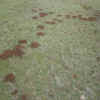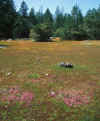


Mimulus angustatus fresh gopher mounds patches of Mimulus in the field
Effects of patchy disturbance on the distribution and pollination of a rare endemic plant
My collaborator on this project (Brian Inouye) and I have been examining the effect of disturbance (in the form of gopher mounds) on the recruitment and performance of Mimulus angustatus at the Las Posadas State Forest, Napa Co, CA. M. angustatus produces a tiny rosette and then a variable number of flowers that are huge relative to the rest of the plant. Through observations and experiments we have found that this Mimulus is far more common on gopher mounds (or in other disturbed areas), germinates at far greater rates on mounds, and has more and larger flowers on mounds. Flowers on mounds also receive more pollen than those off mounds, and outcrossed flowers produce more seeds. Other small annuals in the same meadows (such as Lasthenia californica) appear to do much better in undisturbed areas. We are interested in pursuing questions such as how disturbance affects plant color and how this may influence pollinator visits, whether levels of disturbance from year to year are sufficient to maintain this small population, and whether the effects of gopher mounds are due to reduced competition, nutrient availability, etc.
Poster presentation of Mimulus results from ESA 2004.



Mimulus angustatus
fresh gopher
mounds
patches of
Mimulus in the
field